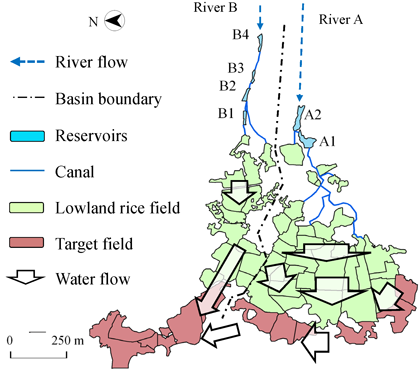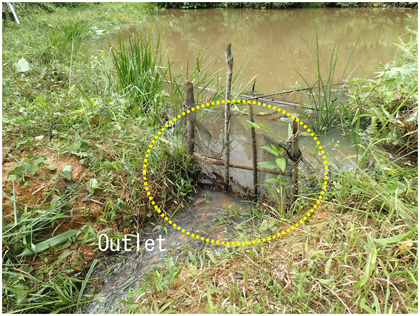Increasing rainy season lowland rice and dry season crop yields in the semi-mountainous villages of Laos using stored water intended for aquaculture
Description
Agricultural fields in the semi-mountainous villages of Laos depend heavily on rainwater. Past water shortages had delayed transplanting of rainy season lowland rice in the lower parts of the fields (Fig. 1), leading to low yields (www.jircas.go.jp/ja/publication/ research_highlights/2015). Moreover, crop cultivation in the dry season has not been conducted due to little precipitation. To complete earlier transplanting and conduct dry season cropping, it is necessary to introduce preparatory irrigation in early rainy season (PIR) and supplemental irrigation in the dry season (SID). Six reservoirs were constructed for aquaculture at N Village in the northwestern part of Vientiane Province, with 8,600 m3 of stored water left unused due to structural issues with the reservoir outlet (Fig. 2). This study aims to formulate a water management plan that includes the introduction of PIR and SID through usage of stored water. It also shows the potential irrigation areas for PIR and SID and the benefits of irrigation.
The stored water is used to irrigate the lower parts of lowland rice fields (Fig. 1) by PIR from July 1 to 15, and the upper parts of lowland fields for soybean (as candidate crop for dry season cropping) by SID four times from December to February. Water balance was calculated under three cases of water management in the reservoirs as follows (Fig. 3): In Case 1, stored water was drained in early April (i.e., conventional use). In Case 2, stored water was drained in February when the 4th SID was conducted while maintaining aquaculture. In Case 3, there was no aquaculture, and all stored water was used for irrigation. Finally, potential irrigation areas for PIR and SID were calculated under three water management scenarios. In Cases 1 and 2 where the minimum water level (water depth of 50 cm) for fish survival was constantly maintained, the results showed that potential irrigation area for PIR was 10.40 ha. In Case 3 where there was no aquaculture, it was 10.95 ha (Table 1). PIR enabled on-time transplanting in about 75% of lowland rice fields in the lower parts (14.1 ha). The potential irrigation areas for SID were 3.17, 3.37, and 3.52 ha in Cases 1, 2 and 3, respectively (Table 1). To calculate the benefits from irrigation, the incomes from the increase in rice and soybean yields due to irrigation and aquaculture, and aquaculture expenditures such as feed costs and compensation paid for losses due to the shortened period in Case 2 and compensation costs for excluding aquaculture in Case 3, were considered. The results showed that revenue growth can be expected from current state (i.e., no irrigation practice) in all Cases (Table 1). From the aspect of securing animal protein resources, it is desirable to maintain aquaculture (Cases 1 and 2).
The results of this research can be applied to other villages where rainy season lowland rice cultivation and aquaculture have been conducted as well as in N Village. However, potential irrigation areas should be calculated according to each village’s own water resource and land use. In addition, in case power pumps or siphons are needed to withdraw water from reservoirs, costs related to equipment purchases and fuel should be included in the calculations.
Figure, table
-
Fig. 1. Overview of river basins A and B in N Village
Note: Transplanting of rainy season lowland rice in the lower parts of lowland rice fields (shown as target field = 14.1 ha) was delayed due to water shortage in the early rainy season. -
Fig. 2. Situation at the reservoir (B2)
Note 1: All reservoirs were constructed for aquaculture.
Note 2: Since the outlets were constructed at a high position in the dam body, a large portion of stored water has remained. -
Fig. 3. Water management utilizing the reservoirs constructed for aquaculture
Note 1: In Cases 1 and 2, minimum water level (50 cm) is maintained for fish survival.
Note 2: In Case 1, stored water in the reservoirs is drained using water pump in April (conventional method).
Note 3: In Case 2, stored water in the reservoirs is drained to coincide with the 4th SID. -
Table 1. Potential irrigation areas and preliminary calculations of projected increases in gross incomes (from current levels) due to irrigation practices Water management Potential irrigation area
(ha)Rice Soybean production
(ton) d
(b×1.4 ton ha-1)Benefits from irrigation (1,000 KIP) Yield
(ton ha-1)Increase in production (ton) c
(a×(3.9-2.2) ton ha-1)Total income (e)
(c×2,500 KIP kg-1
+d×8,000 KIP kg-1)Compensation cost
fNet income
e-fPIR (a) SID (b) Current No irrigation 2.2 0 0 - - 0 Case 1 10.40 3.17 3.9 17.68 4.44 79,704 0 79,704 Case 2 10.40 3.37 3.9 17.68 4.72 81,944 720 81,224 Case 3 10.95 3.52 3.9 18.62 4.92 85,850 6,108 79,742 Note 1: As referred to in the study by Ikeura et al. (2016), the yield of rainy season lowland rice increases from 2.2 ton ha-1 to 3.9 ton ha-1 due to on-time transplanting through PIR.
Note 2: The average yield of soybean due to SID is assumed to be 1.4 ton ha-1.
Note 3: In Case 2, reservoir owners are compensated with feeding fees. In Case 3, gross income from aquaculture is paid to reservoir owners as “loss of income compensation.”
- Affiliation
-
Japan International Research Center for Agricultural Sciences Rural Development Division
- Research project
- Term of research
-
FY2018(FY2014-FY2016)
- Responsible researcher
-
Anzai Toshihiko ( Rural Development Division )
Ikeura Hiroshi ( Rural Development Division )
Chomxaythong Amphone ( National University of Laos )
Keokhamphui Khaykeo ( National University of Laos )
Inkhamseng Somphone ( National University of Laos )
Fujimaki Haruyuki ( Arid Land Research Center, Tottori University )
KAKEN Researcher No.: 90323253 - ほか
- Publication, etc.
-
https://doi.org/10.1007/s10333-018-00685-z
Anzai T et al. (2018) Paddy and Water Environment
Anzai T. at el. (2017) Journal of Rainwater Catchment Systems 23(1):51-58
https://doi.org/10.11408/jsidre.85.II_25Ikeura H at el. (2017) Transactions of The Japanese Society of Irrigation, Drainage and Rural Engineering 304(85-1):II_25-II_33
- Japanese PDF
-
A4611.97 KB
A3314.64 KB
- English PDF
-
A4453.34 KB
A3363.18 KB
- Poster PDF
-
2018_C04_poster.pdf248.16 KB



